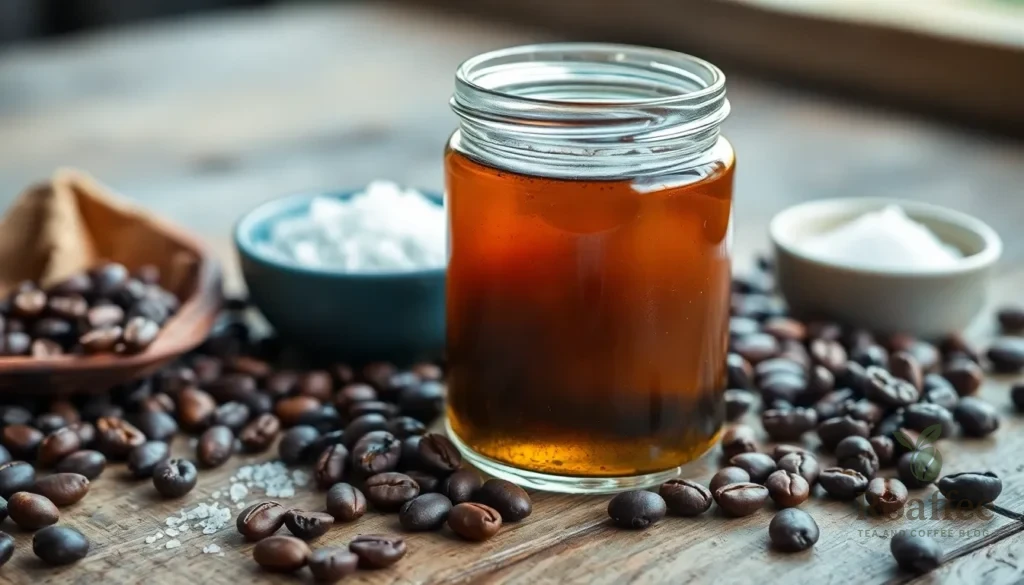We’ve discovered a game-changing ingredient that’ll revolutionize your kitchen: homemade coffee oil. This aromatic infusion captures the rich essence of coffee beans in a versatile oil that’s perfect for both culinary adventures and natural skincare routines.
Coffee oil isn’t just another trendy ingredient – it’s a powerhouse that brings deep, complex flavors to desserts, marinades, and even savory dishes. The natural antioxidants and caffeine compounds make it an excellent addition to your beauty regimen too. Whether you’re looking to create coffee-infused chocolates, add depth to your barbecue rubs, or create a rejuvenating face serum, this oil delivers incredible results.
What Is Coffee Oil
Coffee oil is a concentrated extract derived from coffee beans through various infusion methods that capture the aromatic compounds and beneficial properties of roasted coffee. We create this versatile ingredient by combining high-quality coffee beans with carrier oils like coconut, olive, or jojoba oil through heat infusion or cold extraction processes.
The resulting oil carries the rich essence of coffee while maintaining the beneficial properties of both the coffee beans and the carrier oil. Natural antioxidants from the coffee beans transfer into the oil during the extraction process, creating a product that offers both culinary and cosmetic applications.
Coffee oil differs from coffee essential oil in that it serves as a gentler, more accessible option for home preparation. While essential oils require specialized distillation equipment, coffee oil can be made in any kitchen using simple techniques that preserve the coffee’s natural compounds without harsh processing methods.
The oil’s composition includes caffeine, chlorogenic acids, and other coffee-exact compounds that contribute to its unique properties. These elements make coffee oil particularly effective for both improving flavors in cooking and providing benefits when used in skincare applications.
We can classify coffee oil into two main categories based on preparation methods: hot-infused coffee oil and cold-infused coffee oil. Hot infusion creates a more intense flavor profile in shorter time periods, while cold infusion produces a milder oil with more delicate aromatic qualities over extended extraction periods.
The versatility of coffee oil extends beyond traditional cooking applications. Its natural properties make it suitable for creating custom beauty products, massage oils, and even natural pest deterrents for gardens due to its caffeine content.
Benefits of Homemade Coffee Oil

Homemade coffee oil offers remarkable therapeutic and cosmetic advantages that make it an essential addition to our wellness routine. We’ve discovered that this powerful extract delivers concentrated benefits that extend far beyond its aromatic appeal.
Anti-Inflammatory Properties
Coffee oil serves as a natural remedy for reducing muscle soreness and inflammation throughout our body. The compounds extracted from coffee grounds help soothe irritated tissues and provide relief from physical discomfort. We find this particularly beneficial after intense workouts or long days when our muscles need extra support.
Rich Antioxidant Content
Our homemade coffee oil contains abundant antioxidants and flavonoids that protect against free radical damage. These powerful compounds strengthen our skin’s natural immunity and create a protective barrier against environmental stressors. The high concentration of these beneficial elements makes coffee oil exceptionally effective for maintaining healthy skin.
Moisturizing and Nourishing Effects
Coffee oil excels at restoring moisture to dry or damaged skin areas. We notice immediate improvements in skin hydration when applying this oil regularly. The nourishing properties help maintain a healthy skin appearance while providing long-lasting moisture retention.
Reduces Puffiness and Dark Circles
The caffeine content in coffee oil makes it particularly effective for reducing puffiness around our eyes. We can diminish dark circles and achieve a more refreshed appearance by gently applying the oil to the delicate eye area. This targeted treatment delivers visible results without harsh chemicals.
Anti-Aging Benefits
Coffee oil naturally tightens and brightens our skin due to its concentrated antioxidant content. The oil helps improve skin elasticity and promotes a more youthful appearance over time. We appreciate how this natural solution addresses multiple aging concerns simultaneously.
Versatile Application Methods
We can use coffee oil directly on our skin or incorporate it into homemade scrubs for additional exfoliating benefits. This versatility allows us to customize our skincare routine based on exact needs and preferences. The oil blends well with other natural ingredients to create personalized beauty treatments.
| Benefit Category | Primary Effect | Application Method |
|---|---|---|
| Anti-inflammatory | Reduces muscle soreness | Direct application or massage |
| Antioxidant protection | Fights free radicals | Daily skincare routine |
| Moisturizing | Restores skin hydration | Apply to dry areas |
| Puffiness reduction | Diminishes eye bags | Gentle eye area application |
| Anti-aging | Tightens and brightens | Regular facial use |
| Exfoliation | Removes dead skin | Mixed with scrub ingredients |
Ingredients
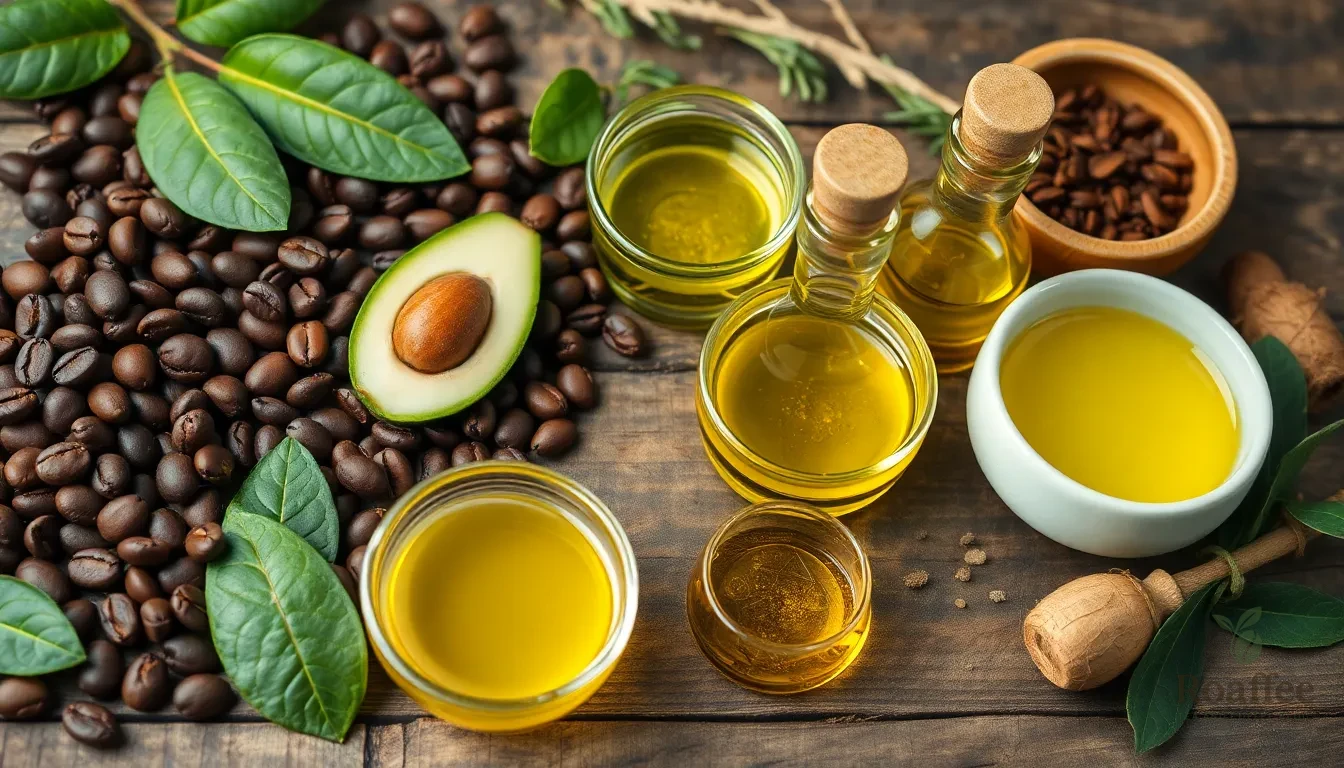
Creating coffee oil at home requires just a few key ingredients that work together to produce a rich, aromatic oil perfect for culinary and cosmetic applications. We’ll break down each component to help you choose the best options for your exact needs.
Coffee Beans
We recommend using organic coffee beans for the highest quality and most potent results. Both roasted and green coffee beans work beautifully, each offering distinct characteristics for your coffee oil.
- Roasted coffee beans produce a fresh, familiar coffee aroma that works perfectly for culinary applications and energizing skincare products
- Green coffee beans create a sweeter, more aromatic profile with enhanced antioxidant properties
- Grind level: Use slightly ground or coarsely ground beans rather than fine powder to prevent over-extraction and easier straining
- Quantity: Plan for approximately 2 tablespoons of ground coffee per 4 ounces of carrier oil
Carrier Oil Options
The carrier oil you select determines both the therapeutic properties and application methods of your finished coffee oil. We’ve found these options deliver the best results:
| Carrier Oil | Best Use | Key Benefits |
|---|---|---|
| Avocado oil | Skincare and cooking | Rich, nourishing, deeply hydrating |
| Jojoba oil | Face and body care | Light texture, skin-friendly absorption |
| Sesame oil | Massage and aromatherapy | Traditional base with warming properties |
| Coconut oil | Multi-purpose applications | Solid at room temperature, antimicrobial |
| Olive oil | Culinary and general use | Readily available, stable for cooking |
Choose oils that align with your intended use, whether for topical application or culinary enhancement.
Optional Add-ins
These additional ingredients can enhance your coffee oil’s aroma, therapeutic benefits, and overall effectiveness:
- Essential oils: Add 2-3 drops of citrus essential oils like sweet orange or lemon for uplifting aromatherapy benefits
- Vitamin E oil: Include 1/4 teaspoon per cup of coffee oil to extend shelf life and boost skin nourishing properties
- Vanilla extract: Add a few drops for enhanced aroma when using coffee oil in dessert applications
- Dried herbs: Incorporate lavender or rosemary during infusion for additional therapeutic compounds
Remember that less is more when adding these extras, as coffee should remain the dominant flavor and aroma profile.
Equipment Needed

Creating coffee oil at home requires minimal equipment that most home cooks already have in their kitchens. We recommend gathering these essential tools before beginning the infusion process to ensure smooth preparation and optimal results.
Glass Jar with Tight-Fitting Lid
We need a glass jar with at least 6 ounces capacity to accommodate our coffee grounds and carrier oil mixture. Glass containers preserve the oil’s integrity better than plastic alternatives and prevent unwanted chemical reactions. The tight-fitting lid ensures proper sealing during the infusion process.
Slow Cooker or Heavy-Bottomed Pot
For the warm infusion method, we use a slow cooker to maintain consistent low temperatures throughout the 4-hour process. A heavy-bottomed pot works as an alternative for those without slow cookers. The gentle heat extraction maximizes the coffee’s beneficial compounds without burning the oil.
Straining Equipment
We require cheesecloth, cold brew bags, or fine mesh sieves to separate the infused oil from coffee grounds. These filtering tools ensure our final product remains smooth and free of particulates. Multiple layers of cheesecloth provide the finest filtration for professional-quality results.
Safety Equipment
Oven mitts or potholders become essential when handling hot jars during the warm infusion process. We always prioritize safety when working with heated oils and glass containers. Proper protective equipment prevents burns and ensures confident handling throughout the extraction.
Additional Tools for Optimal Results
A clean towel placed in the slow cooker prevents direct contact between the glass jar and heating element. We also keep spare glass containers ready for storing our finished coffee oil. These simple additions enhance the overall safety and success of our homemade coffee oil production.
Instructions
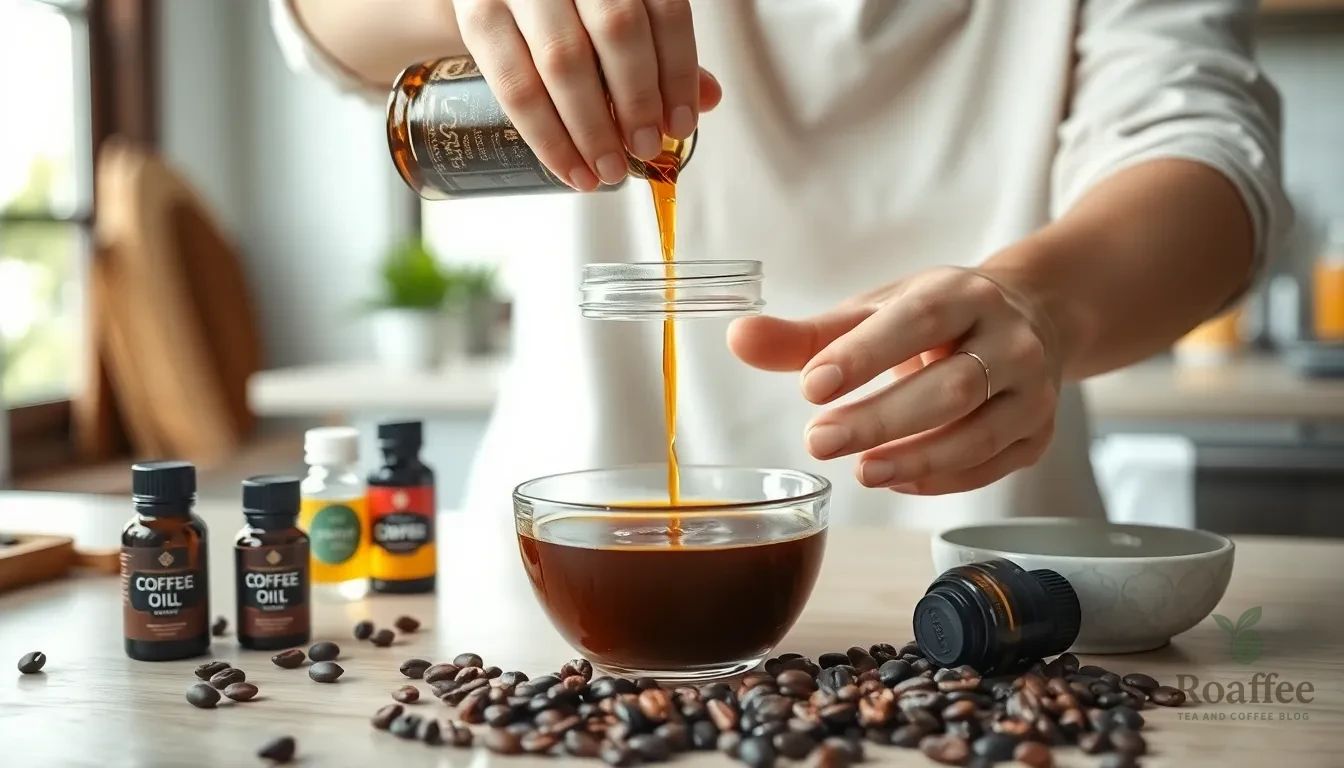
Creating coffee oil at home involves four essential steps that transform ordinary coffee beans into a versatile infused oil. We’ll guide you through each method to ensure perfect results every time.
Prep the Coffee Beans
Begin by selecting 1/4 cup of fresh coffee beans for small batches. We recommend using organic beans when possible for the purest flavor and therapeutic benefits. Grind the beans to a consistency similar to drip coffee grounds, avoiding powder-fine textures that can make filtering difficult. Store-bought ground coffee works well if you prefer convenience, though freshly ground beans deliver superior results.
Choose Your Extraction Method
Two primary methods exist for extracting coffee oil: cold infusion and heat infusion. Cold infusion preserves delicate compounds through slow extraction over several weeks, while heat infusion accelerates the process but may sacrifice some subtle aromatics. Your choice depends on your timeline and desired flavor profile.
Cold Infusion Method
Place the prepared coffee grounds in a clean glass jar with a tight-fitting lid. Cover the grounds completely with your chosen carrier oil, ensuring no coffee particles remain exposed to air. Seal the jar securely and store at room temperature for 2 to 4 weeks. This gentle extraction method maintains the coffee’s most fragile beneficial compounds while creating a smooth, well-rounded oil.
Heat Infusion Method
Set up a double boiler by filling a pot halfway with water and placing a heat-safe bowl on top. Add your carrier oil and coffee grounds to the bowl, then heat on low simmer (around setting 3) for 1 to 7 hours. Stir occasionally to prevent settling and ensure even extraction. Alternatively, use a slow cooker on the “low” setting for approximately 4 hours with a clean towel placed under the jar lid for added safety.
| Method | Time Required | Temperature | Benefits |
|---|---|---|---|
| Cold Infusion | 2-4 weeks | Room temperature | Preserves delicate compounds |
| Heat Infusion | 1-7 hours | Low simmer | Faster extraction |
| Slow Cooker | 4 hours | Low setting | Consistent temperature |
Strain and Filter
Allow the oil to cool completely if you used the heat method. Pour the infused oil through a coffee filter, cheesecloth, or fine mesh strainer to remove all coffee grounds. Press the grounds gently with a spoon to extract maximum oil without forcing particles through the filter. Multiple filtering passes may be necessary for crystal-clear oil.
Store Properly
Transfer the strained coffee oil into a clean, airtight glass jar or bottle. Label with the infusion date and ingredients for future reference. Store in a cool, dark place such as a pantry or cupboard to preserve freshness and extend shelf life. Properly stored coffee oil maintains its potency for several months when kept away from heat and direct sunlight.
Different Coffee Oil Variations

Customizing your coffee oil opens doors to endless aromatic possibilities that suit different preferences and purposes. We can create specialized versions by adjusting our coffee selection or adding complementary essential oils to enhance exact characteristics.
Espresso Oil
Espresso oil delivers the most intense coffee experience we can achieve at home. We start with finely ground espresso beans rather than regular coffee grounds to capture the concentrated essence that makes this variation special. The fine grind allows for maximum surface area contact with our carrier oil during the infusion process.
When creating espresso oil, we recommend using a 1:2 ratio of espresso grounds to carrier oil for optimal strength. Dark roast espresso beans work exceptionally well because their robust flavor profile translates beautifully into the finished oil. We follow the same warm infusion method described earlier, heating the mixture in our slow cooker for 4 hours to extract the full depth of espresso character.
This variation proves ideal for culinary applications where we want bold coffee flavor. Espresso oil enhances chocolate desserts, adds complexity to marinades, and creates luxurious massage oils with an energizing aroma that awakens the senses.
Vanilla Coffee Oil
Vanilla coffee oil combines the warmth of coffee with the sweet comfort of vanilla for a perfectly balanced aromatic experience. We create this variation by adding vanilla essential oil drops to our finished coffee-infused oil or by blending vanilla with coffee essential oil for diffuser applications.
For topical use, we add 3 to 5 drops of vanilla essential oil per 4 ounces of completed coffee oil. This ratio provides noticeable vanilla notes without overpowering the coffee base. When making diffuser blends, we combine 3 drops of coffee oil with 3 drops of vanilla oil for a harmonious “vanilla latte” scent that fills any room with cozy warmth.
The vanilla addition transforms our coffee oil into an excellent choice for skincare products and massage oils. This combination offers antioxidant benefits from the coffee while the vanilla provides soothing properties that help calm irritated skin and create a spa-like experience at home.
Cinnamon Coffee Oil
Cinnamon coffee oil brings spicy warmth that perfectly complements coffee’s natural richness. We achieve this variation by incorporating cinnamon bark essential oil into our finished coffee oil, creating a complex blend that stimulates both the senses and circulation.
For topical applications, we add 2 to 3 drops of cinnamon bark essential oil per 4 ounces of coffee oil. Cinnamon bark oil is potent, so we start with less and adjust according to our preference. For diffuser blends, we create a “cinnamon latte” scent using 3 drops of coffee oil combined with 1 drop of cinnamon bark oil.
This spicy variation excels in massage applications because cinnamon naturally promotes blood circulation and provides warming sensations that complement coffee’s anti-inflammatory properties. We find cinnamon coffee oil particularly effective for morning routines when we want an invigorating start to our day. The combination also works wonderfully in homemade soaps and lip balms where we want both therapeutic benefits and appealing scent profiles.
Storage and Shelf Life
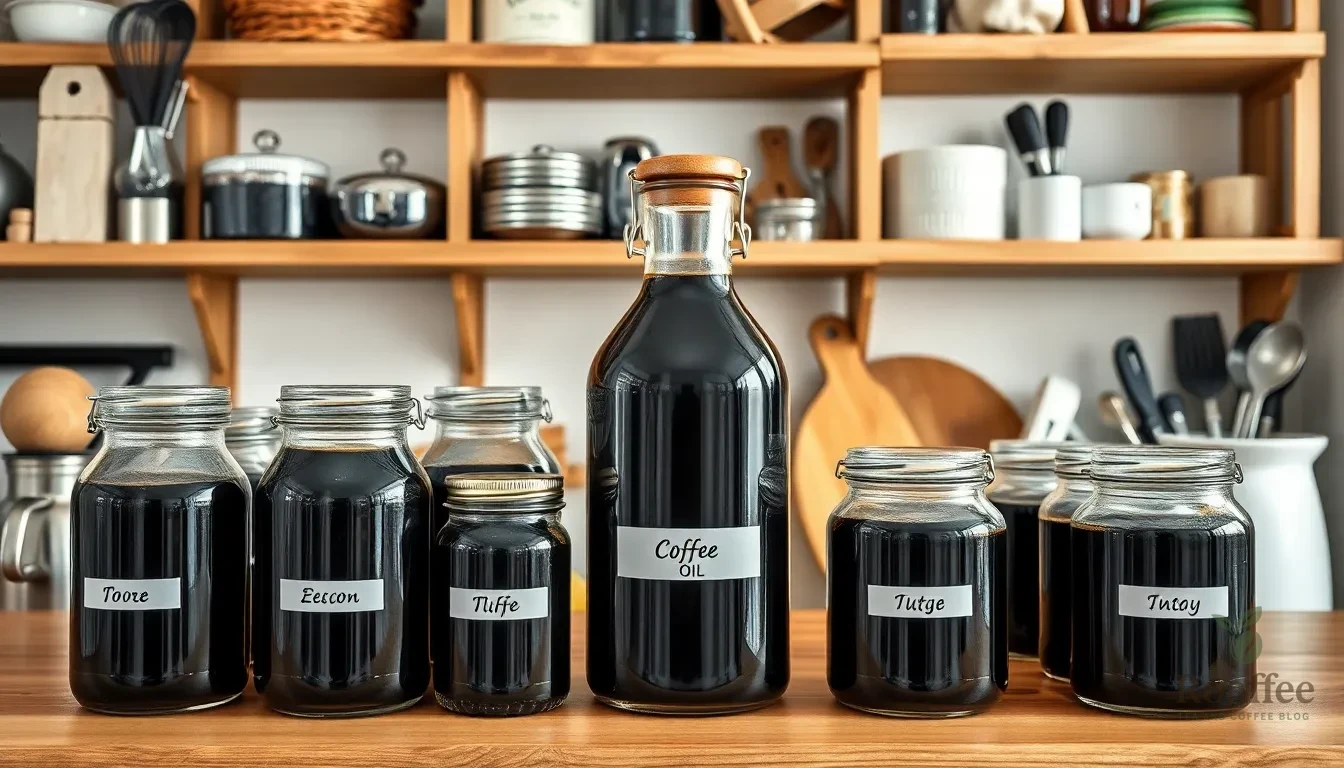
Proper storage extends the life of our homemade coffee oil and preserves its beneficial properties. We recommend storing the finished oil in dark glass containers to protect it from light exposure that accelerates oxidation. Mason jars with tight-fitting lids work exceptionally well for this purpose.
Temperature control plays a crucial role in maintaining oil quality. We store our coffee oil in cool dry places away from direct sunlight and heat sources. Kitchen cupboards or pantries provide ideal storage conditions that prevent the lipid breakdown common in coffee-based products.
The shelf life of coffee oil depends on several factors including storage conditions and the carrier oil used. Fresh coffee oil typically maintains its potency for 3 to 6 months when stored properly. Beyond this timeframe oxidation and rancidity increase significantly due to the natural lipid content in coffee beans.
| Storage Factor | Recommendation |
|---|---|
| Container type | Dark glass bottles with tight lids |
| Temperature | Cool room temperature (60-70°F) |
| Light exposure | Store in dark cupboards or pantries |
| Typical shelf life | 3-6 months |
| Signs of spoilage | Rancid smell or change in consistency |
We monitor our coffee oil regularly for signs of deterioration. Rancid odors or changes in consistency indicate that the oil has passed its prime. The natural lipids in coffee beans make up approximately 15% of the dry weight making them particularly susceptible to oxidation when exposed to oxygen moisture heat and light.
Refrigeration can extend shelf life slightly but may cause some carrier oils to solidify. We bring refrigerated coffee oil to room temperature before use to restore its liquid consistency. Labeling containers with preparation dates helps us track freshness and rotate our supply effectively.
Small batch preparation ensures we always have fresh coffee oil available. We recommend making quantities that can be used within the recommended timeframe rather than large batches that might spoil before use.
How to Use Coffee Oil
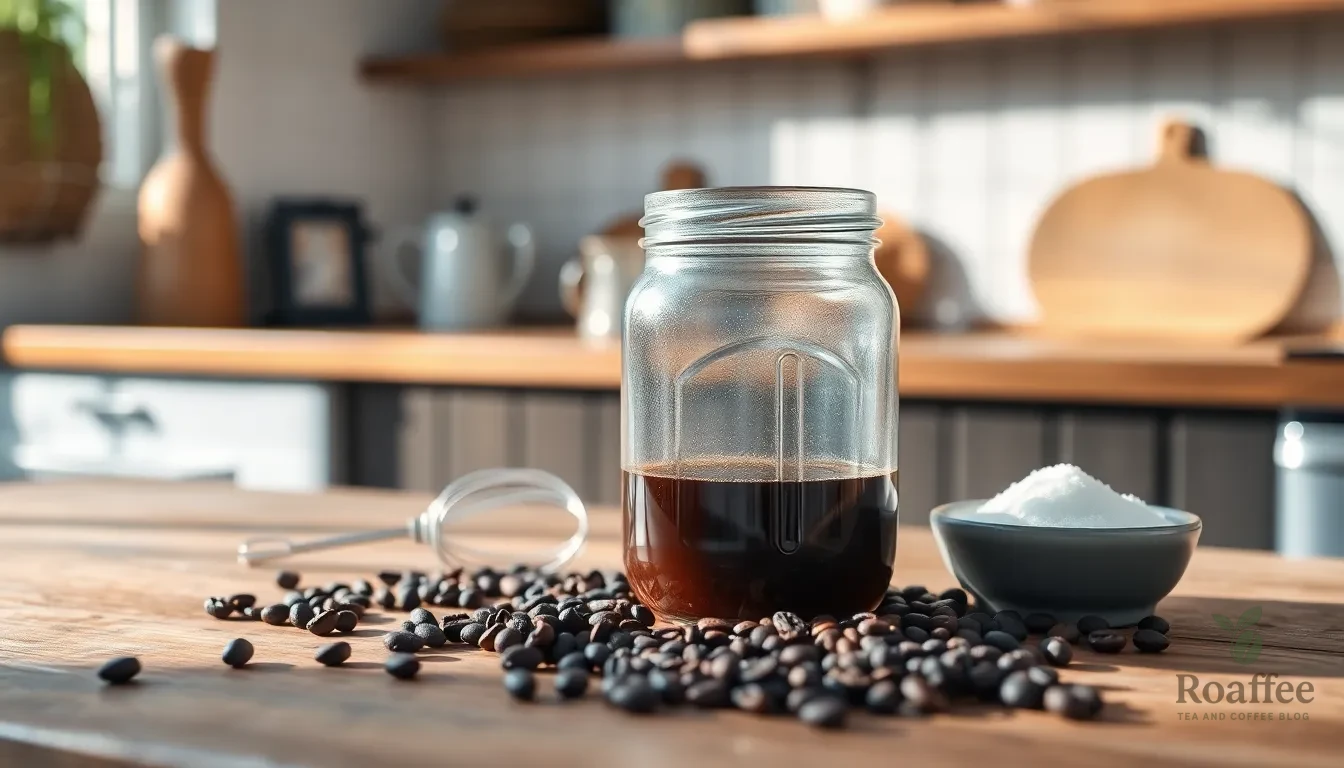
Now that we’ve mastered the art of making coffee oil at home, let’s explore the diverse ways this aromatic treasure can transform our daily routines. From improving our culinary creations to revolutionizing our skincare regimen, coffee oil offers remarkable versatility that extends far beyond its origins as a simple bean extract.
Culinary Applications
Coffee oil offers limited but intriguing culinary possibilities that require careful consideration for food safety. We can create coffee-flavored extracts by incorporating small amounts of our homemade oil into dessert preparations, particularly when creating chocolate-based treats that complement coffee’s rich profile. The concentrated nature of coffee oil makes it unsuitable for direct cooking applications like traditional cooking oils.
When we do venture into culinary uses, we focus on improving desserts and confections where coffee oil can add subtle aroma without overwhelming the dish. Chocolate truffles, ganache, and specialty cakes benefit from just a few drops of our homemade coffee oil, creating depth and complexity in flavor profiles. We always ensure our coffee oil meets food safety standards before incorporating it into any edible preparations.
Beauty and Skincare Uses
Coffee oil transforms our skincare routine with its powerful moisturizing and anti-aging properties. We can create luxurious face masks by mixing our coffee oil with olive oil and gently massaging the blend onto clean skin, allowing the natural compounds to firm and rejuvenate our complexion. The oil’s natural caffeine content works wonders for reducing puffiness and dark circles when we dab it gently under our eyes.
Our homemade coffee oil serves as an excellent base for body scrubs when combined with sugar or salt, creating a natural exfoliant that leaves skin radiant and smooth. We incorporate it into DIY lotions, lip balms, and massage butters to harness its skin-firming benefits. Hair care applications include adding a few drops to our regular conditioner or creating scalp treatments that promote healthy hair growth and add natural shine.
| Skincare Application | Method | Benefits |
|---|---|---|
| Face masks | Mix with olive oil and massage | Moisturizing, anti-aging, skin firming |
| Under-eye treatment | Gentle dabbing motion | Reduces puffiness and dark circles |
| Body scrubs | Combine with sugar or salt | Natural exfoliation, radiant skin |
| Hair care | Add to conditioner or create scalp treatments | Promotes growth, adds shine |
Aromatherapy Uses
Coffee oil’s warm, inviting aroma makes it a standout choice for aromatherapy applications that promote relaxation and stress relief. We diffuse our homemade coffee oil in personal diffusers to create a calming environment that harnesses coffee’s natural mood-improving properties. The rich scent acts as an effective olfactory cleanser, masking unwanted odors while providing a pleasant coffee fragrance throughout our living spaces.
Massage applications showcase coffee oil’s therapeutic potential when we blend it with carrier oils like jojoba or coconut oil to soothe tired muscles and calm the mind. The oil’s natural compounds work synergistically with massage techniques to reduce muscle tension and promote overall relaxation. We often incorporate coffee oil into our evening routines, using it in oil warmers or adding a few drops to bath water for an aromatic spa experience.
Perfumery applications highlight coffee oil’s sophisticated scent profile, particularly in men’s fragrances where the warm, earthy notes create lasting impressions. We blend our coffee oil with complementary essential oils to create custom fragrances that capture coffee’s essence while maintaining balance and depth.
Troubleshooting Tips
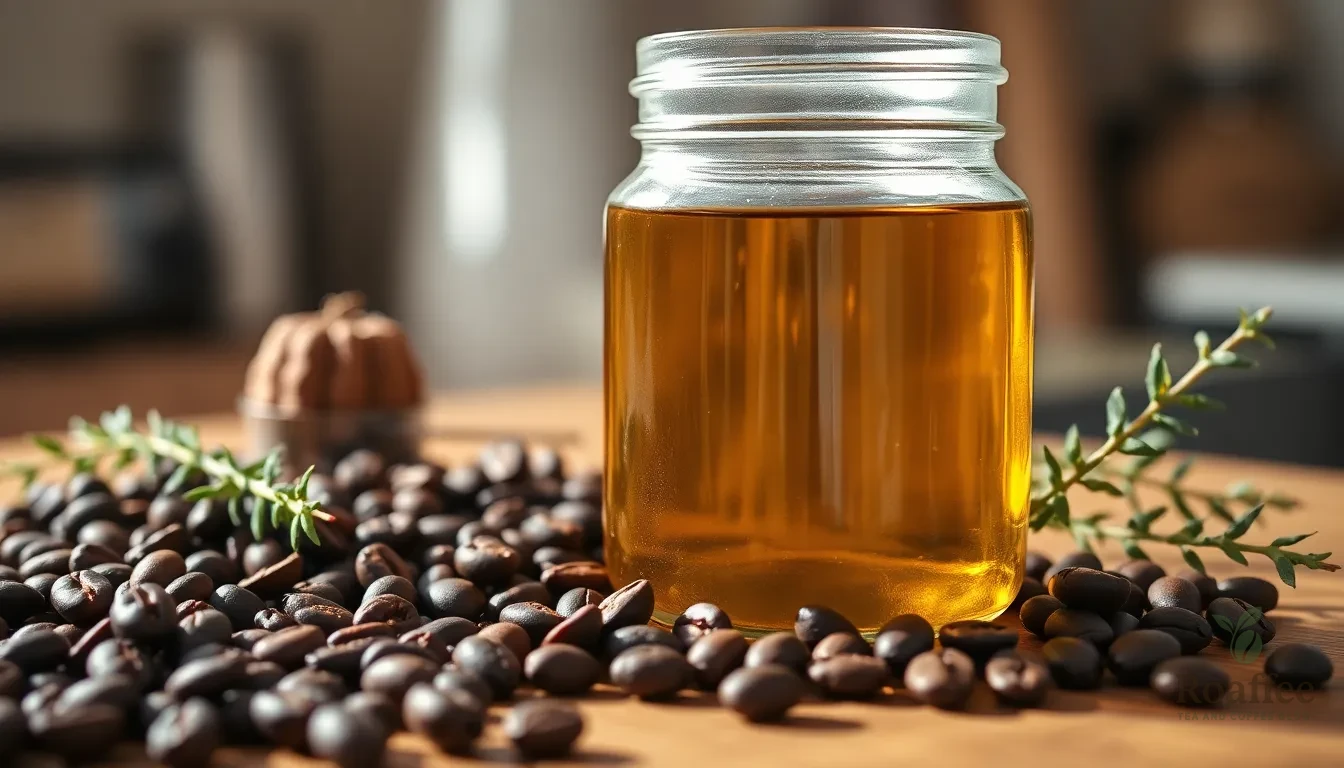
Making coffee oil at home can present several challenges, but we’ve compiled answers to help you create the perfect batch every time. Heat management stands as the most critical factor in successful coffee oil production, requiring careful attention to temperature control throughout the process.
Temperature Control Issues
We recommend maintaining low heat settings during the warm infusion method to prevent burning the coffee or carrier oil. Your double boiler water should simmer gently without reaching a rolling boil, keeping the oil temperature around 140-160°F. If you notice the oil becoming too hot or developing a burnt smell, immediately remove it from heat and allow it to cool before continuing.
Straining Difficulties
Coffee particles can create cloudy oil if not properly removed during the straining process. We suggest using multiple layers of cheesecloth or high-quality coffee filters to achieve crystal-clear results. Allow gravity to work during straining rather than pressing or squeezing the grounds, which can force unwanted particles through the filter.
Infusion Time Problems
Cold infusion methods require patience, typically taking 2 to 4 weeks for optimal extraction. We notice many beginners rush this process, resulting in weak or underdeveloped flavors. Shake your jar gently every few days during cold infusion to redistribute the coffee grounds and ensure even extraction.
Oil Selection Mistakes
Choosing the wrong carrier oil can significantly impact your final product’s quality and shelf life. We recommend avoiding oils with strong competing scents when making coffee oil for skincare applications. Jojoba oil, rosehip seed oil, and sesame oil provide excellent absorption properties without overwhelming the coffee aroma.
Storage and Preservation Challenges
Improper storage leads to rancidity and reduced potency in homemade coffee oil. We store our finished products in dark glass containers away from direct sunlight and heat sources. Room temperature storage works best for most carrier oils, though refrigeration can extend shelf life for certain oil types.
Extraction Strength Issues
Weak coffee oil often results from insufficient coffee-to-oil ratios or inadequate extraction time. We use approximately 2 tablespoons of ground coffee per 1/4 cup of carrier oil for optimal strength. Adjusting these ratios allows you to customize the intensity according to your intended use.
Quality Control Measures
Regular testing during the infusion process helps identify potential problems early. We check our oil’s aroma, color, and consistency throughout the extraction period. Fresh coffee oil should smell rich and aromatic without any off-putting or rancid odors that indicate spoilage or contamination.
Conclusion
We’ve shown you how to transform simple coffee beans into a versatile oil that serves multiple purposes in your daily routine. With just a few ingredients and basic equipment you can create a product that’s both luxurious and practical.
The beauty of homemade coffee oil lies in its adaptability. Whether you’re seeking to enhance your skincare routine or add depth to your culinary creations this oil delivers consistent results. The process is straightforward and the rewards are immediate.
Your homemade coffee oil will become an invaluable addition to your kitchen and bathroom cabinet. We encourage you to experiment with different variations and discover which applications work best for your lifestyle. The investment in time and ingredients pays dividends in quality and satisfaction.
Frequently Asked Questions
What is homemade coffee oil and how is it different from coffee essential oil?
Coffee oil is a concentrated extract made by infusing coffee beans with carrier oils like coconut, olive, or jojoba oil. Unlike coffee essential oil that requires specialized equipment, coffee oil can be easily made at home using simple techniques. It captures the aromatic compounds and beneficial properties of roasted coffee while offering both culinary and cosmetic applications.
What are the main benefits of using coffee oil for skincare?
Coffee oil offers multiple skincare benefits including anti-inflammatory properties that reduce muscle soreness, rich antioxidant content that protects against free radical damage, and excellent moisturizing capabilities for dry skin. It also helps reduce puffiness and dark circles around the eyes while providing anti-aging benefits by tightening and brightening the skin.
Which carrier oils work best for making coffee oil at home?
The best carrier oils for coffee oil include avocado oil, jojoba oil, sesame oil, coconut oil, and olive oil. Each offers unique benefits – avocado oil is rich in vitamins, jojoba oil closely mimics skin’s natural oils, coconut oil has antimicrobial properties, and olive oil provides excellent moisturizing benefits for both culinary and skincare applications.
What’s the difference between cold infusion and heat infusion methods?
Cold infusion preserves delicate compounds over 2-4 weeks by slowly extracting coffee essence at room temperature, while heat infusion accelerates the process to 1-7 hours using gentle heat. Cold infusion maintains more aromatic compounds and antioxidants, whereas heat infusion is faster but may reduce some beneficial properties due to temperature exposure.
How long does homemade coffee oil last and how should it be stored?
Homemade coffee oil typically lasts 3-6 months when stored properly in dark glass containers in cool, dry places away from direct sunlight and heat sources. Signs of spoilage include rancid smells or changes in consistency. Refrigeration can slightly extend shelf life, but some carrier oils may solidify and need to return to room temperature before use.
Can coffee oil be used for cooking and what are the best culinary applications?
Coffee oil is excellent for enhancing desserts like chocolate truffles and ganache, but should not be used for direct cooking applications due to potential burning. It works well in marinades, barbecue rubs, and as a finishing oil for desserts. The oil adds rich coffee flavor to baked goods and specialty dishes when used appropriately.
What equipment do I need to make coffee oil at home?
Essential equipment includes a glass jar with tight-fitting lid, slow cooker or heavy-bottomed pot for warm infusion, and straining equipment like cheesecloth or fine mesh sieves. Safety equipment such as oven mitts is recommended for handling hot jars. A clean towel in the slow cooker can enhance safety during the infusion process.
How do I know if my coffee oil has gone bad?
Signs of spoiled coffee oil include rancid or off-putting smells, changes in consistency, unusual cloudiness, or separation that doesn’t resolve when stirred. Fresh coffee oil should maintain its characteristic coffee aroma and smooth texture. If you notice any of these spoilage signs, it’s best to discard the oil and make a fresh batch.

